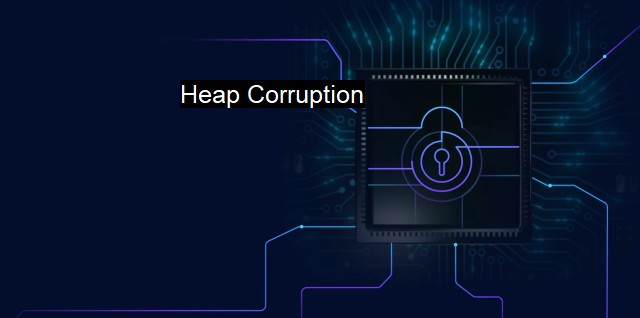What is Heap Corruption?
Understanding Heap Corruption and Its Impacts on Cybersecurity: Analysis and Prevention Techniques
Heap corruption is among the many errors that can compromise system security, with serious implications especially in the ever-evolving internet world where cybersecurity threats are continuously emerging. Understanding what heap corruption is and what it entails can greatly assist in curbing this significant cybersecurity challenge.Heap corruption is a specific type of error which happens when a program damages the heap causing its data to be altered in a way not expected by the system. Heap is a region of a computer's memory space that is used for dynamic memory allocation. By dynamic, it means memory can be allocated or de-allocated during the runtime of a program. This allocation/de-allocation procedure is handled by the heap manager that ensures the process is done without hitches.
Corrupting the heap can occur in several ways, including when a buffer overflow introduces random data into the heap or when an invalid pointer overwrites meta-data in the heap. More specifically, several operations can cause a heap corruption: double freeing a heap block, irregular manipulation of heap blocks, or allocation of a block size that exceeds heap's space. These scenarios can result in stack overflow or a faulty value, thereby not only undermining system performance, but also wreaking havoc on cybersecurity.
A large majority of cybersecurity breaches occur due to malicious intent bent on exploiting system vulnerabilities. One common method of exploitation associated with heap corruption is creating a buffer overflow. This buffer overflow may subsequently give ill-intentioned actors unauthorized access to system resources, including critical data and sensitive system processes. This can then allow the malicious entities to remotely control or manipulate the compromised system or, worse still, steal personal and confidential information. Hence, heap corruption implicitly poses substantial risks to data security and system integrity.
Heap corruption can also lead to system instability and crashes, thereby compromising the reliability of systems and applications. This can ultimately disrupt business operations when systems cannot run effectively, leading to significant financial costs and potential reputation damage due to perceived poor security practices.
Detecting and troubleshooting heap corruption issues can be challenging. Heap corruption is typically a latent error; by the time the consequences of the corruption become apparent and the relevant system crashes, the actual error that caused the corruption might have occurred some time ago. Therefore, it's difficult to backtrack the system processes and pinpoint the precise operation that led to the corruption.
Another important aspect is related to antivirus measures against heap corruption. Given that heap corruptions can be weapons for hackers to hack your system, it is extremely important that antivirus software is equipped to guard against this. Antivirus solutions should be able to detect irregularities and potential breaches and copiously scan for signatures typical of buffer overflow or other such corrupting manipulations.
Strong programming techniques can also go a long way in preventing heap corruption. Using object-oriented programming, ensuring good encapsulation do not only make heap corruption less likely but can also make it easier to spot and fix.
Heap corruption represents a serious potential security flaw that can facilitate unauthorized access, system instability, data breaches, and other undesirable effects. Handling heap corruption, therefore, requires sound cybersecurity measures, efficient programming approaches, and reliable antivirus solutions. In our interconnected digital world where data breaches can have severe consequences professionally and personally, the need for understanding and guarding against heap corruption cannot be overstated.

Heap Corruption FAQs
What is heap corruption and how does it happen in the context of cybersecurity and antivirus?
Heap corruption is a type of memory error that occurs when a program attempts to write to a memory address outside of the allocated memory space. In the context of cybersecurity and antivirus, heap corruption can happen due to a variety of reasons such as buffer overflows, use-after-free errors, and other memory-related vulnerabilities.What are some common symptoms of heap corruption in the context of cybersecurity and antivirus?
Common symptoms of heap corruption in the context of cybersecurity and antivirus include crashes, freezes, unexpected behavior, and in some cases, security vulnerabilities. In addition, heap corruption may also cause other memory-related issues, such as memory leaks or data corruption.How can heap corruption be prevented in the context of cybersecurity and antivirus?
Heap corruption can be prevented in the context of cybersecurity and antivirus by adopting secure coding practices such as input validation, memory bounds checking, and using safe string functions. Furthermore, using runtime protection mechanisms such as canaries, address space layout randomization (ASLR), and data execution prevention (DEP) can help prevent heap corruption and other types of memory errors.What should I do if I suspect heap corruption in my system in the context of cybersecurity and antivirus?
If you suspect heap corruption in your system in the context of cybersecurity and antivirus, you should immediately stop using the affected application and run a malware scan using your antivirus software. You should also check for any updates or patches that may have been released for the application, as these may address the heap corruption issue. Finally, if the issue persists, you should contact the vendor or developer of the affected software for further assistance.| | A | | | B | | | C | | | D | | | E | | | F | | | G | | | H | | | I | | | J | | | K | | | L | | | M | |
| | N | | | O | | | P | | | Q | | | R | | | S | | | T | | | U | | | V | | | W | | | X | | | Y | | | Z | |
| | 1 | | | 2 | | | 3 | | | 4 | | | 7 | | | 8 | | |||||||